Biological Dentistry and Its Positive Effects on the Whole Body
Stephanie Vergote*
Member of Swiss Biohealth Academy
Received Date: 27 May, 2019; Accepted Date: 06 June, 2019; Published Date: 14 June, 2019
*Corresponding author: Stephanie Vergote – Member of Swiss Biohealth Academy, Swiss Biohealth Clinic, Brückenstrasse 15, 8280 Kreuzlingen, Switzerland. Tel: +41716782000; Email: stephanie.vergote@swiss-biohealth.com
Citation: Vergote S (2019) Biological Dentistry and Its Positive Effects on the Whole Body. Cu Tr Ca Al Me: CTCAM-119.
Abstract
This article demonstrates the intraoral interference fields, which are root canal treated teeth, metals and NICOs. Bacteria in root canal treated teeth produce highly toxic hydrogen sulfides (Thioether/Mercaptane), metals show cytotoxic, immunological and carcinogenic effects and NICOs consist of increased inflammatory mediators like RANTES, FGF-2 and IL-1ra.
By using the Swiss Bio health Concept and eliminating these interference fields, it is possible to activate the healing process, switch on to the parasympathetic mode and having positive effects on the whole body metabolism. The great benefit of zirconia implants and the different designs and types of the SDS implants facilitates the immediate implantation in almost every case. Biological dentistry plays an important role to the whole body and brings a great benefit to every patient.
One out of two Americans suffer from immune disorders. If we look attentively at the changes occurring in our environment, we will notice some trends running in parallel: an exponential increase in chronic diseases, a similarly exponential trend of increasing strain on our immune system, but also an exponential increase in organic nutritional and behavioral concepts (Figure 1 and Figure 2).
Chronic diseases, such as cancer, ALS, Alzheimer’s disease, Parkinson’s disease, MS, Crohn’s disease and chronic fatigue syndrome, are increasing at an explosive rate, and extrapolation of the curves shows that within a few years, everyone living in the Western world will be affected by at least one of these diseases.
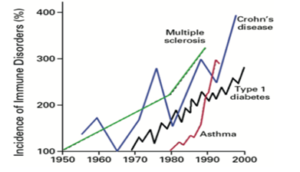 Figure 1: Incidence of Immune Disorders (Bach 2002).
Figure 1: Incidence of Immune Disorders (Bach 2002).
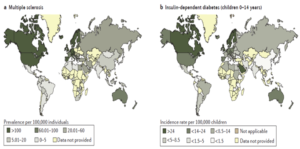
Figure 2: The geographical distribution of autoimmune diseases (Bach 2008).
A change in mindset is urgently required, as there are unfortunately certain factors in our environment that pose a progressively intensive risk to our health: increasing electromagnetic radiation in the form of high gigahertz frequencies related to mobile communications, WLAN and DECT technology. Also, the addition of titanium oxide (E171) to cosmetics, sun screen, oral contraceptives, toothpaste, chewing gum and even yoghurt has led to an increasing intolerance to titanium, which is still being used in alternative medicine and traumatology. Yet even in its purest form ‘Grade 1 titanium’, this chemical element still contains up to 0.20 % iron and traces of nickel as well. This is an alarming fact when you consider that80 % of women in Europe experience an allergic reaction to nickel. More significant risk factors present the intraoral interference fields. There are three main fields who influence the metabolism of our whole body: root canal treated teeth, metals and the NICOs.
Material and Methods
Root Canal Treated Teeth
Root canal treated teeth are dead teeth. Except in dentistry, dead tissue never remains in the body. Even the best micro-endodontic treatment will not be able to realize a perfectly bacteria-proof sealing of the treated root. Accessory side canals and the endo-paro connection through dentinal tubules will always remain. The dead teeth will be populated by various, partly unknown species of anaerobic, pathogenic bacteria which degrade remaining organic tissue and secrete harmful metabolic products (toxins). Richardson et al. identified 75 different bacterial strains in root-treated teeth with apical ostitis. These bacteria can be found particularly often in and around dead teeth: enterococcus faecalis, capnocytophagaochracea, fusobacterium nucleatum, leptotrichiabuccalis, gemellamorbillorum and porphyromonas-gingivalis.
These pathogenic bacteria produce as secondary products of their anaerobic metabolism highly toxic and potentially cancer-causing hydrogen sulfides (Thioether/Mercaptan) from the amino acids cysteine and methionine. By irreversible inhibition of the active center of many endogenous vital enzymes these toxins can become the cause of varied systemic- and organic diseases. The inhibition of important enzymes of the respiratory chain ofmitochondria has been proved in vitro. Every chewing process releases these bacteria and above all their toxins into the lymphatic system of the surrounding tissue. From here they reach the bloodstream (focal infection) and the entire organism (silent inflammation).
There is evidence that toxins and even metals modify the MHC-complexes of our cells. They have a great effect for the increase of immunity disorders.
Metals
Cytotoxic, immunological and carcinogenic effects, as well as influences on metabolism, have been scientifically proven for various metals, such as mercury, gold, platinum, copper, cobalt, aluminum, iron and chromium. Usually, a few days after insertion into the mouth, metal components can be detected everywhere in the body (dissertation submitted by Dr. Volz, University of Ulm, 1991: “Proof of the invasion of amalgam in the pulp tissue by means of neutron activation analysis and energy loss spectroscopy”).
These metals strain the body due to their toxicity, since they can bind to proteins, enzymes and cell membranes in ionized form (sulfhydryl groups) and influence their function. The immunological effects are particularly dangerous, as they can trigger different types of allergies (type IV hypersensitivity), foreign body-induced inflammation by titanium and autoimmune diseases due to deletion of the MHC code. There is also an electrical component, because in the age of mobile communications, WLAN, Wi-Fi, DECT technology, radar, etc., these metals scatter, reflect, modulate, amplify and mobilize electromagnetic radiation unchecked. Particularly in the case of titanium implants, which demonstrate an antenna effect, 3G and 4G networks heat up the surrounding bone by several degrees celsius. According to Dr. Volker von Baehr, the intolerance level of titanium implants now is at 10 % to 25 % among the German population, and can be verified by the ‘titanium stimulation test’. Prof. Vera Stejskal from the Karolinska Institute (www.melisa.org) considers the intolerance ratio to be even higher. As does Dr. Bernd Bremer, Senior Physician for Medical Materials Science at the University of Hannover: he estimates the intolerance level to be 50 %, and is currently conducting a study on this topic. According to Dr. Volz, peri-implantitis is nothing more than the clinical expression of intolerance. This has also been confirmed by a paper published in Düsseldorf on the occasion of the 2014 annual meeting of the DGI (Deutsche Gesellschaft für Implantologie e.V., a German society for implantology). The paper prepared by the University of Freiburg successfully demonstrated the presence of titanium particles in the surrounding soft and hard tissue in just under 80 % of peri-implantitis cases.
Recent studies and lectures by well-known authors and speakers such as Prof. Dr. Therheyden, formerly president of the largest implantological society DGI (Deutsche Gesellschaft fürImplantologie e.V.) show that “titanium rusts” and can be found in the surrounding soft and hard tissue (Figure 3).
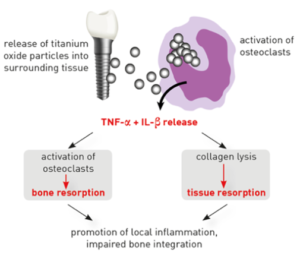
Figure 3: Titanium particles in the tissue induce an inflammatory response (IMD Labor Berlin).
NICO (Neuralgia-Inducing Cavitational Osteonecrosis)
By using the non-biological protocol to remove wisdom teeth, high dose adrenaline block in the lower jaw, the wrong diet, lack of micronutrients and lack of Vitamin D, the body does not switch to the parasympathetic mode which would be necessary for effective healing. Under these circumstances, the bone defect is unable to heal, which is why around 90 % of all wisdom tooth operations develop to a NICO. While the gum tissue and the compact ado heal, there remains a cavity, which is either completely empty, filled with pure fat or with a mixture of fat and dead trabeculae (Figure 4). 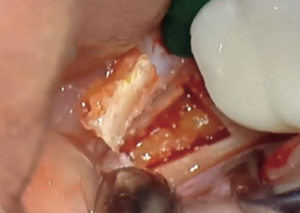
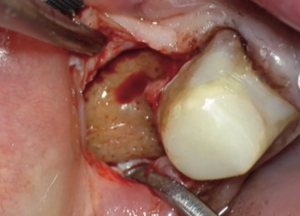 Figure 4: NICO intraoperative (Swiss BioHealth Clinic).
Figure 4: NICO intraoperative (Swiss BioHealth Clinic).
The significantly increased inflammatory mediators in the NICO are RANTES and FGF-2. Both of these factors are also always found in the tissue of serious illnesses like ALS, MS, rheumatoid arthritis and breast cancer.IL-1-ra functions as a masking cap, so that dangerous inflammatory mediators as RANTES and FGF-2 (see below) are not detected and fought by the immune system (Figure 5 and Figure 6).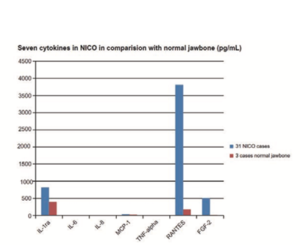 Figure 5: Distribution of seven cytokines in NICO (n=31) and normal jawbone (n=3) (values in pg/ml) (Lechner und Baehr 2018).
Figure 5: Distribution of seven cytokines in NICO (n=31) and normal jawbone (n=3) (values in pg/ml) (Lechner und Baehr 2018).
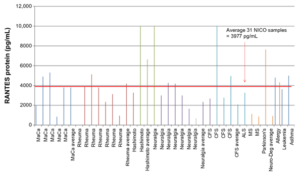
Figure 6: RANTES in NICO tissue with cohort assigned to diseases (Lechner und Baehr 2013).
NICO tissue does not only contain viruses, fungi, bacteria, parasites, FGF-2, RANTES and fat cysts, but also large amounts of mercury, arsenic, lead or aluminum and recently more and more glyphosate, a pesticide.
Particularly in Lyme disease patients, great amounts of Borellia, Babesia and Bartonella are found in NICOs. Here, they meet a perfect environment to replicate and transmit their toxins by nerve fibers throughout the organism.
The Swiss BioHealth Concept
By considering all these factors, the biological treatment concept is established. The concept of biological dentistry, THE SWISS BIOHEALTH CONCEPT, has been formulated and tested in detail by Dr. Volz. In one session all dental problems are eliminated. When all potential disturbing factors such as metals, osteonecrosis, and root canal treated teeth and other interference fields are completely removed, the immune system is able to carry out its work in an optimal manner, to reliably assimilate the implants and to eliminate system stress. To ensure maximum safety after clearance of the NICOs we test with the ART (Autonome Response Test) according to Dr. Klinghardt to verify that all infected material has been removed.
A high LDL value (low-density lipoprotein = ‘bad cholesterol’) of over 1.4 g/L indicates a high propensity for inflammation. A low D3 value of below 70 ng/ml reduces the chance of forming healthy bones, and correlates to a weak immune system. For the operation patients will be prepared to the supplement Basic Immune for four weeks in order to achieve the optimal necessary blood level of vitamins, minerals and fatty acids.
This diagram shows how we treat patients in the Swiss BioHealth Clinic (Figure 7):
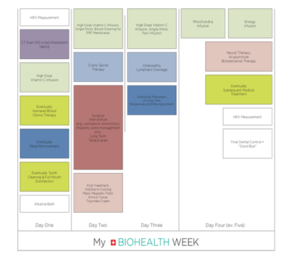
Figure 7: My biohealth week (Swiss Biohealth Clinic).
After removing teeth and/or titan implants, an immediate implantation in this area is pursued. The best material definitely is zirconia:
Zirconia demonstrates many positive effects. It is immunologically neutral, metal-free, has no free electrons, and its ivory color delivers excellent results in terms of aesthetics. Periimplantit is which is common around titanium implants does not exist. Soft tissue (gingiva) grows onto the zirconia implant as well as bone does. This was demonstrated 20 years ago by Dr Hans Rudelt (Hamburg-Eppendorf University in cooperation with the University of Tokyo) by studying the histology of human specimen after a 20-year period. The research group of Prof. Kniha from Munich and Prof. Josep Oliva Damés from Barcelona has also proven this beyond any doubt.
There are over 60 scientific publications on PubMed that attest to the successful use of zirconia implants. The study by Apratim et al. (J Int Soc Prev Community Dent. 2015 May-June; 5(3):147-56.) from 2015 is a good summary, and states that: “The literature research showed the benefits of zirconia and makes it an ideal implant in respect of biocompatibility, osseointegration, favorable soft tissue behavior and aesthetics in terms of appearance and color”.
If we go further and compare ceramic implants to treated teeth (many fillings, crowns), with the ART test we see that ceramic implants show better results than those teeth (they show a chronic inflammation). These teeth are already intraoral interference fields.
More Reasons for the Positive Effects of Zirconia Implants
Zirconia implants are more stable than teeth, the risk for a fracture is less. Around ceramic implants and the crowns we never have caries.
After careful removal of treated teeth, the different types and designs of the SDS implants offer us the possibility to realize the immediate implantation in almost every case (99%).
The knowledge of Dr. Volz has assimilated the current designs and types of zirconia implants (Figure 8):
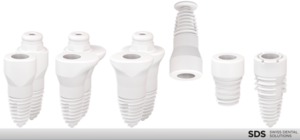
Figure 8: Zirconia implants (SDS).
The entire surface of the body is covered with meridians, which appear through the muscle fascia at certain switching points (acupuncture points) as small, anatomically proven neurovascular bundles. The transmission of information along the meridians has also been demonstrated by injecting radioactively labeled substances at the acupuncture points.
Each of these meridians traverses a specific tooth or tooth group and is associated with certain anatomical structures and organ zones. An inflammation or a disturbance in a specific dental zone thus almost always results in a disturbance in the zone governed by this meridian, and, conversely, in an improvement once the disturbance has been eliminated. Therefore, to maintain organs balance appropriate placement of the implant is very important (Figure 9).
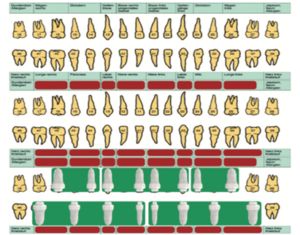
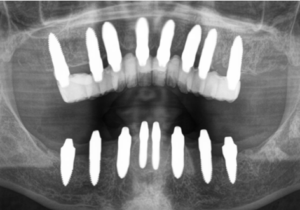
Figure 9: Tooth meridian chart and typical implant scheme.
Therapy Example
This patient had very intense NICOs in the wisdom tooth area and also around the ankylosed endodontic treated teeth.
The following picture shows a patient before the treatment and six months later after insertion of ceramic crowns on the ceramic implants and teeth with previously metal based crowns.
You can observe the relief of the patient, or rather the patient ́s system, in her face and eyes. Also, her subjective feelings confirm the improvement in the following statement:
I first visited the SWISS BIOHEALTH CLINIC in Oct/Nov of 2016. At the time, I had been under medical treatment for Lyme disease and various other bacterial, viral and fungal related illnesses. I had been experiencing chronic illness and pain for about two years. I was unable to walk without pain in my joints and muscles. I also experienced trouble breathing, had sore throat most of the time and laryngitis when I would encounter any type of toxic or chemical smells (cigarette-smoke, perfume, cleaning products). I also did not have full use of my right arm due to a frozen shoulder and the inability to move my right thumb. I felt fatigued and stressed the majority of the time.
The treatments I was receiving in the U.S. were slowly helping to remove toxins and rebuild my body, but it was a slow process. Immediately after having all the metal removed from my mouth and all cavitations cleaned out, I was able to move my shoulder and slowly started to gain some use of my thumb. When I returned home after surgery at SWISS BIOHEALTH, I felt more energy than I had in almost two years. My muscles no longer ached and the pain in my joints started to subside. I started to be able to hike with my dogs again and run on the beach with my horses!
My brain and ability to think became clearer and my level of anxiety decreased significantly. I have also found that when I do come in contact with toxins (smoke, mold, and chemicals), my body still reacts but the symptoms and pain are not as severe and my body is able to clear the toxins faster and resolve the pain (Figure 10).
Catherine Stewart
Point Roberts, WA, USA.
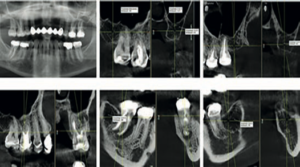
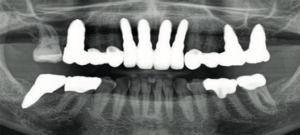
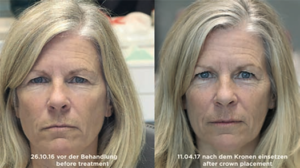
Figure 10: Patient history.
References
- Apratim A, Eachempati P, Krishnappa Salian KK, Singh V, Chhabra S, et al. (2015) Zirconia in dental implantology: A review. In: Journal of International Society of Preventive & Community Dentistry 5: 147–156.
- Bach F (2002) The effect of infections on susceptibility to autoimmune and allergic diseases. In: The New England journal of medicine 347: 911–920.
- Bach J (2018) The hygiene hypothesis in autoimmunity: the role of pathogens and commensals. In: Nature reviews. Immunology 18: 105–120.
- Gomes C, Martinho FC, Barbosa DS, Antunes LS, Póvoa HCC, et al. (2018) Increased Root Canal Endotoxin Levels are Associated with Chronic Apical Periodontitis, Increased Oxidative and Nitrosative Stress, Major Depression, Severity of Depression, and a Lowered Quality of Life. In: Molecular neurobiology 55: 2814-2827.
- Holländer J, Lorenz J, Stübinger S, Hölscher W, Heidemann Det al. (2016) Zirconia Dental Implants: Investigation of Clinical Parameters, Patient Satisfaction, and Microbial Contamination. In: The International journal of oral & maxillofacial implants 31: 855–864.
- IMD Berlin: Metalle sind potentiell toxisch und immunogen.
- IMD Berlin: Titanium intolerance.
- James E, Bouquot; AM, Roberts; P, Person; J, Christian (2018) Neuralgia-inducing cavitational osteonecrosis (NICO). In: Qeios. DOI: 10.32388/688744.
- Kavyashree M, Harish PV, Mishra SK, Chowdhary R (2019) Cell Phone Radiation Effect on Bone-to-Implant Osseointegration: A Preliminary Histologic Evaluation in Rabbits. In: The International journal of oral & maxillofacial implants 34: 643–650.
- Klinghardt Dietrich: A comprehensive review of heavy metal detoxification and clinical pearls from 30 years of medical practice.
- Lechner J, von Baehr V (2013) RANTES and fibroblast growth factor 2 in jawbone cavitations: triggers for systemic disease? In: International journal of general medicine 6: 277–290.
- Lechner, J, Baehr VV (2018): Impact of Endodontically Treated Teeth on Systemic Diseases. In: Dentistry 08 (03). DOI: 10.4172/2161-1122.1000476.
- Lechner J, Noumbissi S, von Baehr V (2018) Titanium implants and silent inflammation in jawbone-a critical interplay of dissolved titanium particles and cytokines TNF-α and RANTES/CCL5 on overall health? In: The EPMA journal 9: 331–343.
- Lechner J, Rudi T, von Baehr V (2018) Osteoimmunology of tumor necrosis factor-alpha, IL-6, and RANTES/CCL5: a review of known and poorly understood inflammatory patterns in osteonecrosis. In: Clinical, cosmetic and investigational dentistry 10: 251–262.
- Lorenz J, Giulini N, Hölscher W, Schwiertz A, Schwarz F, et al. (2019) Prospective controlled clinical study investigating long-term clinical parameters, patient satisfaction, and microbial contamination of zirconia implants. In: Clinical implant dentistry and related research 21: 263–271.
- Persson S1, Edlund MB, Claesson R, Carlsson J (1990) The formation of hydrogen sulfide and methyl mercaptan by oral bacteria. In: Oral Microbiol Immunol 5: 195–201.
- Ruiz PA, Morón B, Becker HM, Lang S, Atrott K, et al. (2017): Titanium dioxide nanoparticles exacerbate DSS-induced colitis: role of the NLRP3 inflammasome: Gut 66: 1216-1224.
- Safioti LM1, Kotsakis GA1, Pozhitkov AE2, Chung WO2, Daubert DM (2017) Increased Levels of Dissolved Titanium Are Associated With Peri-Implantitis – A Cross-Sectional Study. In: Journal of periodontology 88: 436–442.
